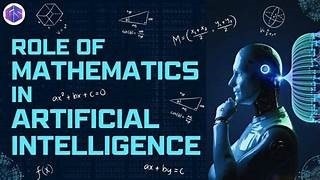Artificial intelligence (AI) and machine learning (ML) are transforming industries, shaping the future of technology, and revolutionizing how we interact with the world. But behind the sophistication of AI models and learning algorithms lies the foundational bedrock of **mathematics**. From solving simple optimization problems to creating complex neural networks, mathematics plays a central role in making machines “intelligent.”
In this blog, we’ll explore how different branches of mathematics contribute to AI and ML and how understanding these principles is essential for building smart, efficient algorithms.
1. Linear Algebra: The Language of Data
At the heart of machine learning is **linear algebra**. Data is often represented in matrices (rows and columns of numbers), and operations on these matrices are fundamental for data processing, transformations, and computations in ML.
– **Vectors and Matrices**: In machine learning, data points are often represented as vectors, and datasets as matrices. For instance, a dataset with multiple features (like height, weight, age) is typically modeled as a matrix where each row represents an individual, and each column represents a feature.
– **Matrix Operations**: Neural networks, a key AI architecture, rely on matrix operations such as matrix multiplication and addition. These operations are essential for computing weighted sums of inputs, a process that underpins how neural networks make predictions.
– **Dimensionality Reduction**: Techniques like **Principal Component Analysis (PCA)** are used to reduce the number of variables in a dataset while preserving its essential structure. This is a linear algebra-based method used to simplify complex data for better computational efficiency.
2. Calculus: The Backbone of Optimization
**Calculus** is vital for understanding the inner workings of how machine learning models are trained. When training a model, we aim to minimize errors by adjusting parameters, and calculus provides the tools for this process.
– **Gradient Descent**: Gradient descent is a common optimization algorithm used to minimize the loss function, a measure of how well a model is performing. It uses **derivatives** to find the direction in which the function decreases the fastest, allowing the model to update its parameters to reduce errors.
– **Backpropagation in Neural Networks**: In deep learning, backpropagation is the process through which neural networks learn. It involves computing gradients using derivatives to understand how each parameter (or weight) in the network affects the overall error. This helps in adjusting weights to minimize the loss.
3. Probability and Statistics: Making Predictions from Data
**Probability theory** and **statistics** provide the foundation for making predictions and handling uncertainty in AI models. These fields help AI systems reason under uncertainty, which is crucial in real-world decision-making.
– **Bayesian Inference**: Bayesian models use probability to infer the likelihood of events or hypotheses based on prior knowledge and new data. This approach is used in various AI applications, including spam filtering, recommendation systems, and even self-driving cars.
– **Markov Chains and Hidden Markov Models**: These are statistical models that describe systems that transition from one state to another, where each transition depends only on the current state. They are widely used in natural language processing (NLP), speech recognition, and predicting stock market trends.
– **Expectation-Maximization**: A statistical algorithm used to find maximum likelihood estimates in models with hidden variables, such as Gaussian Mixture Models (GMMs). It plays a crucial role in clustering tasks, where the goal is to categorize data points into different groups.
4. Optimization Theory: Solving Problems Efficiently
In AI, many tasks can be framed as optimization problems, where we seek to minimize (or maximize) an objective function. **Optimization theory** provides the tools to solve these problems.
– **Convex Optimization**: A large class of optimization problems in machine learning is convex, meaning the objective function has a single global minimum. Convex optimization techniques ensure that algorithms like Support Vector Machines (SVMs) and linear regression find the best possible solution efficiently.
– **Stochastic Optimization**: Machine learning algorithms often work with large datasets where calculating the full gradient might be computationally expensive. **Stochastic Gradient Descent (SGD)** is an efficient alternative that uses a subset of data to approximate the gradient, speeding up the learning process.
5. Discrete Mathematics: Structure and Logic
**Discrete mathematics** deals with countable, distinct elements and is crucial in areas like algorithms and data structures, both of which are integral to AI.
**Graph Theory**: Many problems in AI are modeled as graphs, with nodes representing entities and edges representing relationships. For example, in social network analysis, graphs help identify communities or influential individuals. In recommendation systems, graphs are used to model user-item relationships.
**Boolean Algebra and Logic**: Boolean algebra is used in decision-making algorithms and search engines. Logic is the foundation for AI planning, constraint satisfaction problems, and reasoning in expert systems.
6. Information Theory: Quantifying Uncertainty
**Information theory** is concerned with quantifying the amount of information in a system and understanding the limits of data compression and transmission. In machine learning:
– **Entropy**: Entropy is a measure of uncertainty or randomness in data. Algorithms like **decision trees** use entropy to determine how informative a particular feature is when making predictions.
– **Kullback-Leibler Divergence**: This is a measure of how one probability distribution differs from another. It’s commonly used in machine learning to compare distributions and in training generative models like Variational Autoencoders (VAEs).
Conclusion: Mathematics as the Core of AI and ML
Mathematics is the silent powerhouse that fuels the development of artificial intelligence and machine learning algorithms. From data representation using linear algebra to optimization techniques from calculus and probability models that handle uncertainty, each branch of mathematics contributes to the advancement of AI. As AI continues to evolve, the demand for deeper mathematical understanding grows, making it essential for practitioners in the field to strengthen their mathematical foundation.
Understanding these mathematical principles not only allows AI engineers and data scientists to build better models but also helps them push the boundaries of what AI can achieve. Whether it’s making more accurate predictions, solving complex optimization problems, or enabling machines to “learn” from vast amounts of data, mathematics remains at the heart of artificial intelligence and machine learning.
This blog provides a broad view of how mathematics supports AI and ML. Depending on your audience, you could dive deeper into specific applications like neural networks or focus on real-world case studies where mathematical concepts are applied in AI systems.


